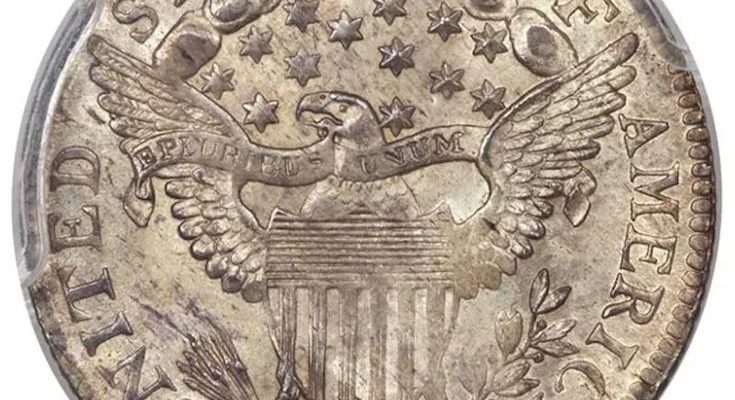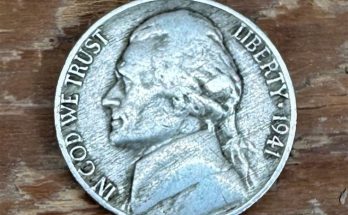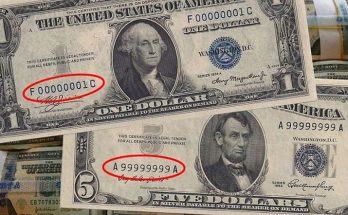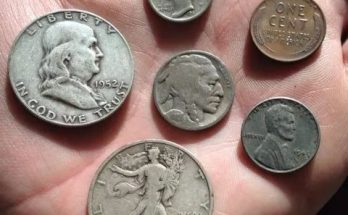The dime was the first coin made by the U.S. Mint, even before any Mint building existed. George Washington ordered the first run of dimes in 1792, which were made on a borrowed press kept in the owner’s basement.
The first dime produced in a U.S. Mint building was struck in 1796. The earliest 10-cent coins pictured Lady Liberty, either in bust or full profile form. From 1916 to 1945, designers put wings on Liberty’s head, leading people to mistake her for Mercury. (Today, these dimes are referred to as Mercury Dimes.) President Roosevelt’s image first appeared on the dime in 1946.
Traditionally, dimes were predominately silver, though some early ones were made of copper due to a silver shortage. The Coinage Act of 1965 removed all silver, replacing it with a combination of copper and nickel.
Like other coins, the most valuable dimes survive the years in mint condition. This does not mean the coin appears as it did when it was minted. Changes in coloration are normal and even expected. Cleaning a coin may detract from its value. The dimes that command the most value are in excellent condition and rare, due to various reasons, including production errors, small quantities produced or large quantities melted for their silver content.
Two organizations certify coins, the Professional Coin Grading Service (PCGS) and the Numismatic Guaranty Corporation (NGC). Both use the Sheldon Scale to assign a numerical rating, from 1 to 70. Coins rated 60 or higher are also referred to as “mint” state coins and are considered the most valuable.
These are 25 of the most valuable dimes, and they are worth a combined $8.6 million.
Bottom Line: 1945 S Micro S Full Band Mercury Dime
:quality(80)/granite-web-prod/6b/28/6b28597428564fcab26cbe494374a3a3.jpeg)
The 1945 S dime is the only one known to have the Micro S mintmark appear on the reverse side of the coin. While there’s no shortage of 1945 S dimes, only a little over 1,200 have been graded mint condition by NGC.
In addition, dimes from this year struck in San Francisco (as this one was) tend to be poorly struck so those with full bands are rare.
This one is in mint condition.
Bottom Line: 1860 Liberty Seated Dime
:quality(80)/granite-web-prod/e7/a7/e7a72063adf444af8b426e8314e2a949.jpeg)
In 1860, the words “United States of America” moved to the front of the dime and replaced the stars. The wreath on the reverse side was enlarged to fill the space.
While this change was made to coins minted in New Orleans (O coins) and Philadelphia (no mint mark), coins made in San Francisco remained the same. More than 600,000 dimes were produced in Philadelphia, so these are not particularly rare.
This dime, produced in Philadelphia, is one of over 100 dimes from 1860 certified to be mint state.
Bottom Line: 1968 No S Roosevelt Dime Proof
:quality(80)/granite-web-prod/5d/e3/5de324ccb40d489785dc3825ac309af2.jpeg)
This is the first proof coin that was mistakenly struck without the mint mark, and only about 12 such coins are known to exist.
It’s believed that the San Francisco Mint caught the mistake early and made an adjustment to the die for future coins.
Aside from the fact that this particular coin is in mint condition, there are no mint records, adding mystery and making these coins more in demand.
Bottom Line: 1856 S Seated Liberty Dime
:quality(80)/granite-web-prod/d6/77/d6775df94fd5438a8ffb7596715f8376.jpeg)
This was the first year dimes were produced at the San Francisco Mint. With only 70,000 dimes minted, even low-grade coins are rare.
Overall, the S dimes are worth more than others minted that year.
A coin in mint state like this one is extremely rare.
Bottom Line: 1844 Seated Liberty Dime
:quality(80)/granite-web-prod/06/1c/061c3023d09e4a07be97a26eb52c6fbb.jpeg)
While this coin has a relatively low mintage (only 72,500), there’s no significant shortage of this coin in worn condition.
The coin was nicknamed “Little Orphan Annie,” possibly due to the fact it was unappreciated by collectors.
There are only 15 certified unworn examples of this coin. This one is one of the three finest examples certified by PCGS.
Bottom Line: 1860 O Seated Liberty Dime
:quality(80)/granite-web-prod/a1/af/a1afe23d5b174513ab5ec7c49f9ef9ee.jpeg)
In 1860, both sides of the dime were updated. The Legend Obverse replaced the former Stars Obverse design.
Minted in New Orleans (the O designation), only 40,000 of these dimes were minted, and it’s believed that many of these were melted when Louisiana seceded from the Union in 1861.
This particular coin is one of only three mint state dimes of this type known to exist.
Bottom Line: 1874 Seated Liberty Dime With Arrows Proof
:quality(80)/granite-web-prod/96/b3/96b3c48cf5dd4159aca2353f25f4c8fc.jpeg)
There were only 700 proof dimes minted in Philadelphia in 1874.
This particular coin was certified the highest grade coin of this date by both PCGS and NGC.
Bottom Line: 1798 Large 8 Draped Bust Dime
:quality(80)/granite-web-prod/81/03/8103787e7d374cf9af2b4920aa69caba.jpeg)
While the 1798 Small 8 dime is less common, the “Large 8” dime is also rare.
With only 27,550 minted, those in mint state, as this coin is, are even more valuable.
This coin is unusual in that the reverse die was previously used as the reverse of a 1798 quarter.
Bottom Line: 1846 Seated Liberty Dime
:quality(80)/granite-web-prod/ad/c2/adc2b257d58c4256a06cf4c86283bbd0.jpeg)
With only 31,000 of these dimes produced, the coin is rare in any condition.
This is one of only three 1846 Seated Liberty dimes to be certified mint condition by both certifying agencies and is one of the two finest known to exist.
Bottom Line: 1859 S Seated Liberty Dime
:quality(80)/granite-web-prod/c1/b9/c1b998c0bb754b0eb5656e66424c0e8b.jpeg)
The coin is rare in any condition, but especially in grades very fine and above. This particular coin is in mint condition.
Only one set of dies was used in production, with a total mintage of 60,000, making it the rarest dime of the 1850s.
Bottom Line: 1874 CC Seated Liberty Dime With Arrows
:quality(80)/granite-web-prod/23/c0/23c07f64987345e2ac028fbac160a7d7.jpeg)
The arrows in question appear on either side of the date on the coin, put there to indicate the increase in the coin’s weight starting in 1873.
Produced at the Carson City Mint, there are only five mint-condition examples of this coin known, and it’s estimated that only 35 to 50 in any condition exist.
With only 10,817 of these coins produced, only the 1873 CC No Arrows dime had a smaller mintage.
Bottom Line: 1918 D Full Band Mercury Dime
:quality(80)/granite-web-prod/13/03/130318c8864848ce806cbf651d8bd80a.jpeg)
This mint condition coin from the Denver Mint is rare. Only a few dozen 1918 dimes have been certified with full bands by PCGS.
The central bands on the reverse are at one of the highest points of the coin, causing it to wear out the quickest.
So coins with full bands are particularly prized by collectors.
Bottom Line: 1872 CC Seated Liberty Dime
:quality(80)/granite-web-prod/32/0a/320a349cd6624feeb551dda405445cee.jpeg)
Dimes from the Carson City Mint in 1872 are rare, especially those rated very fine or above. This particular coin is rated mint condition.
The Carson City Mint used the same reverse die for all Liberty Seated dimes from 1871 to 1874. Sometime in 1872, the die developed a light crack which was evident on later coins.
This coin was struck before that crack appeared.
Bottom Line: 1805 4 Berries Draped Bust Dime
:quality(80)/granite-web-prod/77/a2/77a2c205b52649cbb131f374230aa2c6.jpeg)
Only 120,780 dimes were produced in 1805, in two varieties. The more common of the two, the face of the 4 Berries dime was struck from the same die as the earlier 5 Berries version.
The reverse die was new and has only four berries on the olive branch, rather than five.
This particular coin is in mint condition and is considered to be among the finest known.
Bottom Line: 1797 16 Stars Draped Bust Dime
:quality(80)/granite-web-prod/3e/0d/3e0de69ad47f49af89a084b0019bc3c9.jpeg)
There were two key varieties of the 1797 Draped Bust Dim. This version is special because it has 16 stars along the rim of the coin’s obverse, while other versions have 13.
While a pristine version of this coin sold for almost $200,000 at auction, even one in average condition can be worth about $5,000.
Bottom Line: 1916 D Full Band Mercury Dime
:quality(80)/granite-web-prod/fe/2e/fe2e23231e174a32abdce220e661cd41.jpeg)
In 1916, the U.S. Mint modernized the dime, transitioning to a design created by Adolph A. Weinman. While the San Francisco Mints continued to produce the old Barber dimes and the Philadelphia Mint produced both versions, the Denver Mint only produced the new design. By November, the number of dimes had met the national demand, so the Denver Mint ceased producing dimes.
Only 264,000 1916 D dimes were produced. The PCGS has graded 24 dimes full band with varying mint certifications. The full band designation indicates that the coins were struck from fresh dies, resulting in greater detail in the central band on the reverse side of the coin.
This is one of the six highest-rated mint full band dimes of this year. A 1916 D dime in slightly lower condition brought $152,750 at auction in 2013 while one in 2015 brought $94,000. Yet another 1916 D dime in almost as good condition also sold at auction in 2015 for $43,475.
Bottom Line: 1798 Small 8 Draped Bust Dime
:quality(80)/granite-web-prod/5a/6c/5a6cdd98771f4b498437b1a2df6c5209.jpeg)
In 1798, both Small 8 and Large 8 coins were minted. (The 8 refers to the numeral in the date.) The Small 8 is slightly rarer than the Large 8, which of course creates higher demand and value.
The 1798 dimes are unique in that the R in the word “LIBERTY” has a curved tail while the R in AMERICA has a straight tail.
This is the only year in the series of early dimes that a curved tail appears.
Bottom Line: 1871 CC Seated Liberty Dime
:quality(80)/granite-web-prod/d7/a4/d7a45f9f4e98422785b9fe7d2e218202.jpeg)
Possibly the finest example of this coin, it’s in mint condition.
1871 was the first year Carson City produced dimes, and only 20,000 were minted that year.
Since all of these coins went into circulation, it’s believed that only four or five dimes are in mint condition and only 50 to 200 in any other condition exist.
Bottom Line: 1975 No S Roosevelt Dime Proof
:quality(80)/granite-web-prod/35/ea/35eaa99fa14542d38a371601e3846a75.jpeg)
Only two of these dimes are known to exist, making it one of the rarest U.S. dimes. Minted in San Francisco, this coin is missing the mint mark (designated by an “S” on the face of the coin) present on other proof coins.
This was the first time this particular dime sold at a public auction. It previously was part of a six-piece set held by a collector for 31 years.
According to Coin World, this sale is the highest recorded for any U.S. coin from the second half of the 20th century.
Bottom Line: 1800 Draped Bust Dime
:quality(80)/granite-web-prod/39/d0/39d0bec89a9843e3bc18ac13f9eaa46d.jpeg)
Another one of the Draped Bust Dimes, this dime minted in 1800 sold for more than $350,000 at The Eugene H. Gardner Collection of U.S. Coins Signature Auction in New York back in 2014.
Even ones in uncirculated condition can be worth $50,768.
Bottom Line: 1797 13 Stars Draped Bust Dime
:quality(80)/granite-web-prod/6b/41/6b4156fb54124b9188b869a6dbaa609f.jpeg)
The second version of the previously mentioned 1797 Draped Bust Dime came with 13 stars instead of 16.
This version is worth about twice as much as the other, fetching more than $400,000 at auction.
Bottom Line: 1804 14 Star Reverse Draped Bust Dime
:quality(80)/granite-web-prod/f3/6b/f36bdee4b98a4d1dbae30207856c2f06.jpeg)
Two varieties of the 1804 Draped Bust Dime were minted at the Philadelphia Mint. One had 13 stars, while the 14-star one is much more difficult to find.
One lucky bidder got this dime for a cool $650,000 back in 2008, but even about uncirculated versions go for almost $100,000.
Bottom Line: 1796 Draped Bust Dime
:quality(80)/granite-web-prod/7b/0e/7b0ed9dab3d848a397db3bda50dc8ea0.jpeg)
Since the first year that dimes were produced was in 1796, you better believe the 1796 draped bust dime is going to be worth a good amount of money.
One version of this coin sold for almost $900,000 at The Eugene H. Gardner Collection of US Coins Signature Auction in New York in June 2014, but even ones in about uncirculated condition can fetch an estimated $17,456.
Bottom Line: 1873 CC No Arrows Seated Liberty Dime
:quality(80)/granite-web-prod/25/44/2544f83660bf4e84b761aa560b34b72d.jpeg)
Issued by the Carson City Mint (the CC designation), only 12,400 of these coins were issued in 1873.
The standard weight of the dime changed in 1873, and the arrows were added to indicate an increase in weight. The old dimes were supposed to be melted down and recoined at the slightly heavier new standard.
This mint-condition dime is the only one of this quality known to exist. It has been in high demand before, previously selling for $891,250 to complete a set of Carson City Mint coins.
Bottom Line: 1894 S Barber Dime
:quality(80)/granite-web-prod/0e/6f/0e6fad97ddf54a43a4acfb59ce1c25f6.jpeg)
Although a little over 2 million dimes were produced in 1894, it appears that only 24 were minted in San Francisco, making this dime extremely rare.
It’s believed that only nine of these still exist.
This particular coin is in mint condition.

:quality(80)/granite-web-prod/65/23/6523cfb902034f4d9b041247ca142098.jpg)
:quality(80)/granite-web-prod/cd/19/cd19eb36b0a848b2a783ada04435ab8e.jpg)
:quality(80)/granite-web-prod/7a/22/7a228fc176d6429eb8e523e9575d989a.jpg)
:quality(80)/granite-web-prod/3a/50/3a50163e24054b6fb6a25cbb6b7e8c12.jpg)
:quality(80)/granite-web-prod/1d/a2/1da276dd8ddb45dd82358e3a71fe583b.jpg)
:quality(80)/granite-web-prod/e1/da/e1daf012c26543239654d32f11f4bcb0.jpg)
:quality(80)/granite-web-prod/ca/c1/cac17715d31d4969a1d932feb2ffff32.jpg)
:quality(80)/granite-web-prod/47/9f/479f64572ac34f45ae761d1858ca4c3f.jpg)
:quality(80)/granite-web-prod/d7/d8/d7d8558a485f4a369d9519960d1c4eb3.jpg)
:quality(80)/granite-web-prod/4a/0a/4a0a23792f42438abc324b430144c89a.jpg)
:quality(80)/granite-web-prod/d2/ae/d2aec56414bd4a33ae83dec0436b5e46.jpg)
:quality(80)/granite-web-prod/33/9f/339fd5ef697d42cea7baec4a62573a5f.jpg)
:quality(80)/granite-web-prod/07/fe/07fec6cdcc4f4862bf5ebc835540fcc3.jpg)
:quality(80)/granite-web-prod/38/a0/38a0b16a03354addaedc79464d19dcb1.jpg)
:quality(80)/granite-web-prod/d4/da/d4da5df0116341a6bdd9d5c625ab8680.jpeg)
:quality(80)/granite-web-prod/6b/04/6b0494d81c9d40b3868e991578c0ba99.jpg)
:quality(80)/granite-web-prod/36/03/3603f27abe2d4dfbab4ed0895a757781.jpg)
:quality(80)/granite-web-prod/65/d0/65d0289efa894f0981d31d308240819a.jpg)
:quality(80)/granite-web-prod/e8/54/e854ea320ceb4e279b51956b7618832c.jpg)
:quality(80)/granite-web-prod/96/72/967270c430f5441890e8e89cdc742e88.jpeg)
:quality(80)/granite-web-prod/a6/0b/a60bcdc979c346d7a415e4e9724810e7.jpeg)
:quality(80)/granite-web-prod/f1/ce/f1cecbd8183341edb5792e9dd3fc71c2.jpeg)
:quality(80)/granite-web-prod/d2/f4/d2f49be732f94193951aca81176425d8.jpeg)
:quality(80)/granite-web-prod/48/d8/48d8c3f319474c56badc822ce9b5456f.jpg)
:quality(80)/granite-web-prod/e3/f1/e3f183db300e4751a512c3acebbeb4ea.jpg)


